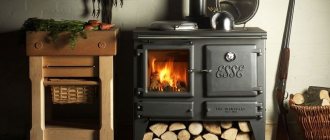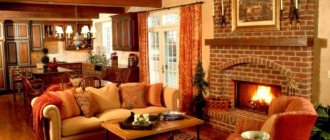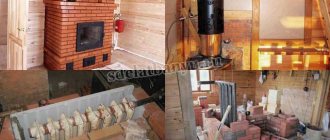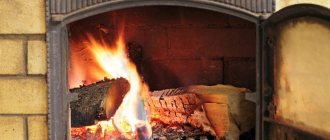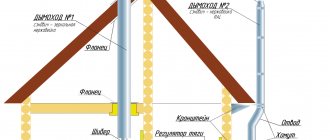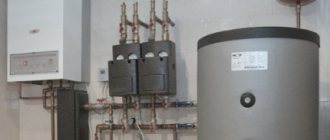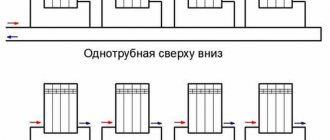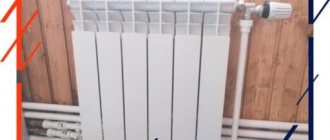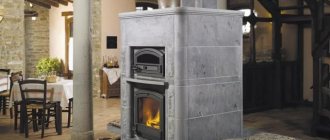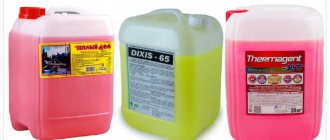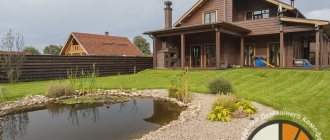Sweden, Denmark, Norway and Finland - the name of any of these Scandinavian countries primarily evokes natural beauty: majestic glaciers and picturesque fjords, clear lakes and vast forests. The caring attitude of Northern Europeans towards this heritage is quite logically reflected in all areas of their activities.
The fireplace Contura 21 C (Contura, Sweden) in concrete with two containers for firewood is a striking example of Scandinavian design with its clean straight lines, minimal decor and emphasized functionality. A steel firebox i20 with fireclay lining was used, the vertically opening door is made of cast iron.
Steel fireplace stove Q-bic (Rais, Denmark) with a built-in hinged base and a firewood rack in the lower part.
The Jasa fireplace (Tulikivi, Finland) with a ceramic finish will fit into both modern and classic interiors. Ceramic 3D cladding decorates its surface, and large doors effectively frame the beauty of the fire. The fireplace has low emissions; combustion air is supplied from outside. The model is perfect for installation in a modern home with low energy consumption.
What is the difference between Finnish home heating and Russian
Russian heating is arranged as follows: a stove or boiler is installed, which can use gas, coal or firewood as fuel. From the boiler, a circuit of a water “jacket” is laid throughout the house - a pipeline in which there is water without circulation. It heats up and releases heat into the room.
Important! There are also wood-burning stoves that distribute heat throughout the room by convection, but “Russian” designs are built from brick or stone.
The Finnish home stove has the following fundamental differences from domestic designs:
- There is no water jacket; it is not required due to the specific method of heat distribution. But some designs have it as an additional element.
- Heat is distributed throughout the house by airborne thermal convection.
- They are made only from cast iron or other heat-conducting metal, which is resistant to heat, but also heats up quickly. The design can be equipped with an insert made of heat-resistant glass.
- Only wood is used as fuel.
Important! The presence of glass adds aesthetic properties to the stove, since combustion and flames can be observed through it.
About the domestic manufacturer
The question is quite logical: how are Russian goods inferior and are they inferior?
The main advantage of Russian wood-burning stoves is their relative affordability. However, domestic heat generators are inferior in build quality. Manufacturers in Finland have made enormous efforts to improve efficiency and have achieved success. The design is such that heat transfer is increased to the highest levels. For example, combustion products enter the chimney already cooled.
On the other hand, fireboxes from domestic manufacturers are surprisingly unpretentious and perform their function under any conditions. Overseas equipment requires more attention and compliance with the rules of use.
Characteristics of the Finnish stove
The product is made of metal structures and serves for space heating, so it has a number of functional characteristics:
- Power. This parameter is characterized by the amount of heat, measured in Joules and generated from fuel combustion. The ideal parameter is considered to be 12 Joules from the combustion of 1 kg of wood in 1 hour. This value is close to 4 kW/hour.
- Keep warm time. Fuel is added to the firebox once every 10 hours, but there are models with volcanic ceramic lining. Such models require fuel renewal once every 22-24 hours.
- Size. It is not the dimensions of the stove itself that are important, but the firebox itself. Sizes vary from 12 to 50 cm.
Important! Finks can be used not only for heating, but also for cooking. A thin hob is installed in the upper part.
Scandinavian style in the exterior
Scandinavians living in cold climates appreciate every minute of warmth that the stingy northern sun gives them. Therefore, in the local area of a Finn or Swede, everything is always ready so that the owner and unexpected guests can sit comfortably, cook something tasty and quickly light a fire if the weather changes suddenly. As for design, the principles are the same as for the interior: maximum natural materials, simple shapes and unlimited comfort. No less important are the thoroughness and reliability of all items, primarily outdoor heating devices.
The modern open fireplace Loke (Jotul, Norway) will create a cozy and attractive atmosphere on the terrace of a country house. Thanks to its stable design, the fireplace will not tip over even in strong winds. It is made from corten steel or regular steel, painted black.
The Roma Garden fireplace (Nordpeis, Norway) can be installed both indoors and outdoors. The model is equipped with a grill grate: it is not only a source of warmth and light at night, but also delicious food. Roma Garden runs on wood and briquettes. The fireplace lining is made of heat-resistant composite.
Thanks to its thoughtful design, the Globe biofireplace (Vauni, Sweden) can also be used outdoors. Its spherical rotating dome serves as protection for the flame if the wind suddenly rises. And the witty design of the model will look appropriate anywhere.
Operating principle of heating stoves
As already mentioned, first firewood is placed in the stove and lit. The firebox is closed with a lining, and the wood begins to burn and the lining begins to heat up.
The air heats up from the lining, and then a physical phenomenon called convection begins. This is the specific ability of air masses to move, circulating around the room and displacing cold air masses. The movement occurs unnoticed by humans, and the room is gently filled with warmth.
Important! Some models are equipped with a water pipe for radiators. Their principle is to combine convection with heating water in pipes, which also heat the room.
Ecology in focus
In modern heating devices, energy efficiency and environmental friendliness are interrelated concepts: the most complete combustion of fuel ensures its economical consumption and reduces emissions. The North European environmental certificate Ecolabel Nordic Swan is awarded only to those fireplaces and stoves that meet perhaps the strictest standards in the world. Heating appliances marked with the Swan mark are CO2 neutral: the amount of carbon dioxide released by the fireplace when burning fuel corresponds to the amount of CO2 consumed by growing trees.
The modern open fireplace Loke (Jotul, Norway) will create a cozy and attractive atmosphere on the terrace of a country house. Thanks to its stable design, the fireplace will not tip over even in strong winds. It is made from corten steel or regular steel, painted black.
Fireplace stove 4640 (HWAM, Denmark) is distinguished by its harmonious, consistent design and technical perfection. It is equipped with a patented Autopilot system that supports the wood burning process in automatic mode. The oven is made of high quality materials and is designed for a long service life.
The vintage-looking model F 400 (Jotul, Norway) is made of cast iron and is designed to heat a room of up to 140 m² - despite its compact size. The F 400 is made of cast iron with an impressive level of heat capacity and is equipped with a Clean Burn function, which guarantees clean and complete combustion of fuel and minimal emissions.
Text: Olga Arkusha
Subscribe to our channel
What types of Finnish heating stoves are there?
There are several varieties and modifications that differ in design, the presence of additional elements and communications. The most popular versions of Scandinavian stoves for home heating will be presented below.
Long burning versions
Prolonged combustion of fuel is achieved by reducing the amount of oxygen inside the combustion chamber. For such structures, a blower is used, which is significantly smaller in volume than the firebox. In this case, the air in the firebox will quickly burn out, preventing strong combustion - the firewood will burn 1.2 - 1.5 times longer than in stoves with chambers of equal volume.
Design and features of a Scandinavian stove
The design of a Finnish stove consists of four main elements:
- Chimney.
- Firebox.
- Lining.
- Kamenka.
- Blower (ash pan).
Schematic diagram of a Finnish stove
The operating principle is not much different from a conventional wood stove. Firewood is placed in the firebox.
An ash pan (or ash pit) is a small chamber in which ash collects. The chimney ensures the removal of combustion products from the room, and the lining is a fire-resistant shell made of stone or steel, which allows heat to be accumulated. The lining plays a special role in this design. It is precisely this that is designed to provide heat accumulation and protect the device from mechanical and chemical damage.
A design feature of the Scandinavian stove can also be called the combustion channel. The device has two channels that are not interconnected. This allows you to increase the rate of heating of the room, increasing the efficiency of solid fuel consumption.
The ash pan is equipped with a retractable structure and a door, which allows for regular cleaning of the device. The door also helps regulate draft, creating the necessary air circulation.
The heater comes in two types in Finnish stoves: open and closed design and, depending on the model, can hold from 20 to 100 kg of fuel.
A distinctive feature of this furnace is the absence of a water circuit. The room is heated by thermal convection. Cold air is taken in from the floor, and then, when heated, the air rises. Thus, there is a natural circulation of cold and hot air flows in the room. To transfer heat into the room, the Finnish stove has special air channels through which heat flows from the firebox into the room.
Advantages of a Scandinavian stove
- uniform air heating;
- safety;
- simplicity of design;
- high warm-up speed;
- magnificent appearance;
- long service life;
- the use of wood as the main type of fuel;
- fuel efficiency;
- environmental friendliness;
- maintaining the required humidity in the room.
It is on environmental friendliness that I would like to place special emphasis, since the Finns pay great attention to the environment in the country. By producing heating devices, they achieve maximum reduction in the emission of harmful substances during the combustion of wood. In addition, the solid fuel used in such stoves does not pose any threat to human health, which cannot be said about diesel or gas heating devices.
It is the choice of raw materials for the furnace that determines the efficiency of the device. The Finns are very careful when it comes to heating, so engineers play a big role in preserving heat inside the structure when the wood is smoldering.
However, Finns pay no less attention to safety. Considering that such wood-burning appliances are mainly purchased for wooden country houses, cottages and bathhouses, manufacturers maximize the fire safety of structures. This is achieved by laying a ceramic cord between all connections of the device. This, in turn, increases the tightness of the furnace and allows you to retain thermal energy for as long as possible.
Another advantage of such designs is the versatility of the parts. If any element or part fails over time, it can always be ordered and installed separately. Many models will accept parts from other manufacturers, so breaking and replacing parts won't be too much of a problem in the future.
Despite all the advantages of Finnish solid fuel heating devices, there are also several disadvantages that you should be aware of before purchasing. The disadvantage of such furnaces is their long heating time and the need to build a solid foundation. And, of course, it wouldn’t hurt to talk about the price of the issue. After all, from domestic manufacturers you can find high-quality, reliable analogues at a much lower cost.
Safety of Finnish fireplaces
The main distinguishing feature of Finnish wood-burning stoves for the home is their safety. It is achieved by completely isolating the fire from the external space behind the stove. Air saturation through the ash pan is carried out through insulated channels, and the chimney hermetically removes combustion products outside the living quarters.
In addition, the design is a solid metal form that is resistant to mechanical stress and destruction from heat. Brick stoves, for example, can burn out over time and collapse from the heat if laid incorrectly, while Finnish stoves are purchased and installed in a monolithic design.
Features of heaters
Stoves with heaters are available in two types:
- closed heaters
- open type heaters With a closed heater, the stoves are suitable for a Russian bath. In them, the fire does not directly touch the stones. Steam is produced by supplying water through a special capillary system, and the resulting steam exits through special holes. During the formation of steam, the pressure increases and it comes out with high intensity, as if a shot is being fired. In a sauna, it is better to use a stove with an open heater to obtain high temperatures with low humidity. Nowadays, models with two modes (sauna mode and bath mode) are more often produced.
Improvements in the design of Finns
1) If the existing stove has good draft and the smoke circulation in it is accessible, then its operation is significantly improved by attaching a shield to it. If its extension is not possible, then you can convert the firebox to the stove, with a sluice and a hinged door. When the stove is fully lined, it can be heated with both wood and coal. 2) By opening the air vents or the pipe door of the furnace, we quickly heat the room air with its internal, more heated, mass than with the outer walls. In the latter case, these stoves transfer heat so slowly.
Above the ceiling of the furnace roof, room or atmospheric air (at the bottom of one of the revolutions) enters the heat chamber of the furnace, from which heated air will flow into the room through a vent placed at the top under the ceiling of the revolutions. Smoke should not penetrate into the chamber; this choke should not be closed during the heating of the stove to remove heat from the smoke as it moves along the revolutions. Even ones have a downward direction of smoke, and odd ones have an upward direction of smoke. In the last turn, a view is placed, through which the smoke falls into the underturn and passes into the chimney.
Popular Finnish brands
The products of several companies with extensive experience in the production of bath stoves are most in demand.
No. 5. Tulikivi
There are not many models in the line of this manufacturer, but they stand out due to their characteristics and design. All stoves are lined with natural stone, which not only significantly increases their aesthetics, but also allows you to create very light steam. The designs are safe: the risk of getting burned when touching the equipment is minimized. The stove does not emit harmful substances into the air. But not everyone will be able to purchase these devices due to the high cost.
Tulikivi
Prices for sauna stoves Tulikivi
sauna stoves Tulikivi
No. 4. Kastor
The company has been producing stoves for about 70 years. During this period, a large number of units with different characteristics were developed.
Kastor
For the production of equipment, heat-resistant steel with a thickness of 5...8 mm is used. Its efficiency exceeds 70%. The furnaces are equipped with filtration and ventilation systems. They have a well-thought-out design that ensures heat retention and protects a person from burns.
Prices for sauna stoves Kastor
sauna stoves Kastor
No. 3. Harvia
The equipment of this brand, which has 60 years of experience in producing wood-burning stoves, can be used without interruption. It is reliable, safe and durable.
Harvia
The firebox is made from heat-resistant steel or cast iron; the door is made of glass resistant to high temperatures. Two independent firewood combustion channels help improve the efficiency of the equipment. The manufacturer has thought out a CO emission system, the level of which is reduced to a minimum.
The stoves are equipped with chimneys and water heating tanks made of heat-resistant material.
Prices for sauna stoves Harvia
sauna stoves Harvia
No. 2. Narvi
The company has no factories outside of Finland. All products are manufactured in this country. Narvi stoves are highly reliable. They are made from durable steel with an enamel protective coating. The equipment is quite simple to operate and maintain. It works for many years.
Narvi
Prices for sauna stoves Narvi
sauna stoves Narvi
No. 1. Helo
Wood burning units from Helo are economical. To heat the air to 80 degrees, one hour and a couple of stacks of logs are enough. After this, the heater is able to maintain the temperature for several more hours. The stoves are made in a classic design. The brand offers a wide range of stoves, their prices are quite affordable.
Helo
It is worth noting that a little over 10 years ago, Helo and Kastor companies merged and since then, products under these brands have been produced at the same production sites.
Prices for Helo sauna stoves
sauna stoves Helo
Video - Testing sauna stoves. Bonfire, Vira, Harvia
Advantages of the Fireplace Center
In our company’s online store you will find a wide selection of heat storage furnaces from leading European manufacturers. Furnaces made in Finland are presented in a wide range of configurations, designs, dimensions, construction and equipment. This type of product is perfect for home, country house, cottage, as well as for representative premises, offices and banks, spa and bath complexes, hotels, shops and other commercial spaces. All products come with reliable guarantees of quality and long service life.
Selection rules
Basic recommendations from professionals:
- You should carefully read the instruction manual, which indicates the preferred heating area, and also describes in detail the situations in which the use of such a unit is not recommended.
- The presence of additional functions (hob, water heating tank, etc.) determines the advantages of a particular model.
- An important factor in choosing a device is the duration of operation after one fill of fuel.
Rules for installing a stove indoors
When installing a heating device, certain requirements must be observed, which will guarantee the safe operation of the unit.
It is important to follow the instructions included with the finished product. By following these recommendations, you can achieve the maximum performance that characterizes your specific model.
Fire safety, the requirements of which are important to comply with when installing a Finnish stove for a home, is ensured by placing a gasket made of fire-resistant material under the structure. It is necessary to lay a proportionate part of the metal sheet in front of the firebox. Care should also be taken to insulate the chimney where it passes through the floors of the house.

